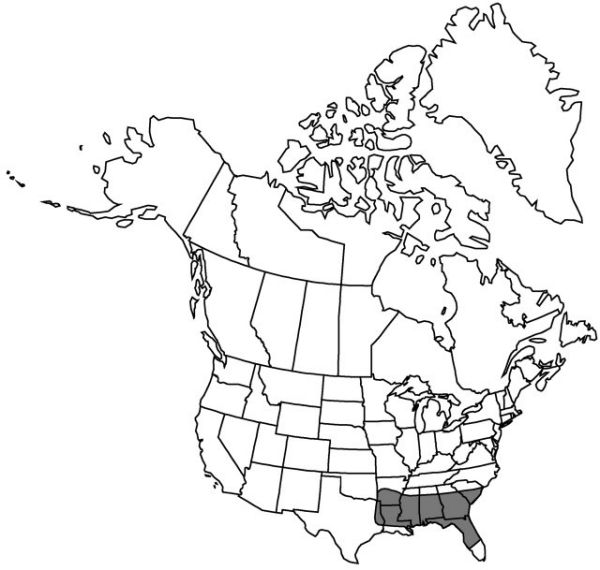Difference between revisions of "Smilax pumila"
Fl. Carol., 244. 1788.
FNA>Volume Importer |
FNA>Volume Importer |
||
| Line 12: | Line 12: | ||
|name=Smilax humilis | |name=Smilax humilis | ||
|authority=Miller | |authority=Miller | ||
| − | }}{{Treatment/ID/Synonym | + | }} {{Treatment/ID/Synonym |
|name=Smilax pubera | |name=Smilax pubera | ||
|authority=Michaux | |authority=Michaux | ||
| − | }}{{Treatment/ID/Synonym | + | }} {{Treatment/ID/Synonym |
|name=Smilax puberula | |name=Smilax puberula | ||
|authority=Kunth | |authority=Kunth | ||
| Line 32: | Line 32: | ||
|habitat=Woods, along streams, sandy soil | |habitat=Woods, along streams, sandy soil | ||
|distribution=Ala.;Ark.;Fla.;Ga.;La.;Miss.;S.C.;Tex. | |distribution=Ala.;Ark.;Fla.;Ga.;La.;Miss.;S.C.;Tex. | ||
| − | |discussion=<p>The red, pointed fruits and densely pubescent herbage of Smilax pumila are distinctive. In Louisiana, the dried leaves are used to prepare a tea for upset stomach.</p><!-- | + | |discussion=<p>The red, pointed fruits and densely pubescent herbage of <i>Smilax pumila</i> are distinctive. In Louisiana, the dried leaves are used to prepare a tea for upset stomach.</p><!-- |
| − | --><p>The name Smilax humilis Miller, which predates S. pumila by 20 years and recently has been determined to apply also to this species, has been proposed for rejection (J. L. Reveal 2000). If that proposal is not adopted, the correct name will be S. humilis.</p> | + | --><p>The name <i>Smilax</i> humilis Miller, which predates <i>S. pumila</i> by 20 years and recently has been determined to apply also to this species, has been proposed for rejection (J. L. Reveal 2000). If that proposal is not adopted, the correct name will be <i>S. humilis</i>.</p> |
|tables= | |tables= | ||
|references= | |references= | ||
| Line 56: | Line 56: | ||
|publication year=1788 | |publication year=1788 | ||
|special status= | |special status= | ||
| − | |source xml=https://jpend@bitbucket.org/aafc-mbb/fna-data-curation.git/src/ | + | |source xml=https://jpend@bitbucket.org/aafc-mbb/fna-data-curation.git/src/8f726806613d60c220dc4493de13607dd3150896/coarse_grained_fna_xml/V26/V26_995.xml |
|genus=Smilax | |genus=Smilax | ||
|species=Smilax pumila | |species=Smilax pumila | ||
Revision as of 16:48, 18 September 2019
Subshrubs or vines; rhizomes black, knotted, 5–6 × 2 cm, often with white to pinkish stolons. Stems perennial, prostrate to clambering, branching, slender, to 1 m, ± woody, densely woolly-pubescent, usually prickly (especially at base). Leaves mostly evergreen, ± evenly disposed; petiole 0.05–0.25 cm, often longer on sterile shoots; blade gray-green, drying to ashy gray-green, obovate to ovate-lanceolate, with 3 prominent veins, 6–10.5 × 5–8 cm, glabrous adaxially, densely puberulent abaxially, base cordate to deeply notched, margins entire, apex bluntly pointed. Umbels 1–7, axillary to leaves, 5–16-flowered, loose, spherical; peduncle 0.2–0.8 cm, shorter than to 1.5 as long as petiole of subtending leaf. Flowers: perianth yellowish; tepals 3–4 mm; anthers much shorter than filaments; ovule 1 per locule; pedicel thin, 0.1–0.4 cm. Berries red, ovoid, 5–8 mm, with acute beaks, not glaucous.
Phenology: Flowering Oct–Nov.
Habitat: Woods, along streams, sandy soil
Distribution

Ala., Ark., Fla., Ga., La., Miss., S.C., Tex.
Discussion
The red, pointed fruits and densely pubescent herbage of Smilax pumila are distinctive. In Louisiana, the dried leaves are used to prepare a tea for upset stomach.
The name Smilax humilis Miller, which predates S. pumila by 20 years and recently has been determined to apply also to this species, has been proposed for rejection (J. L. Reveal 2000). If that proposal is not adopted, the correct name will be S. humilis.
Selected References
None.